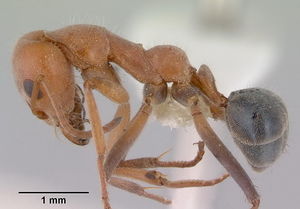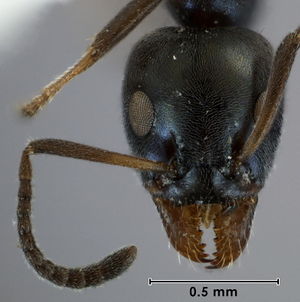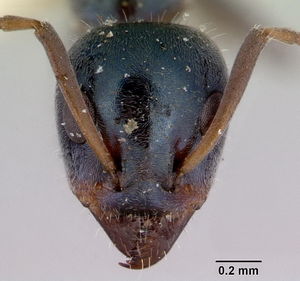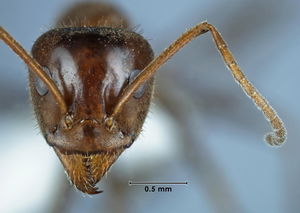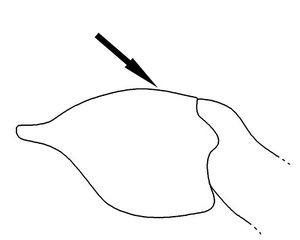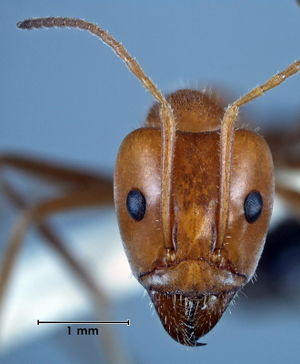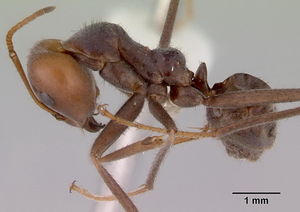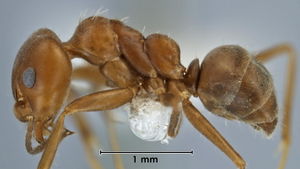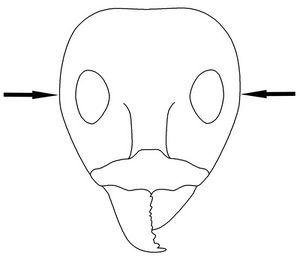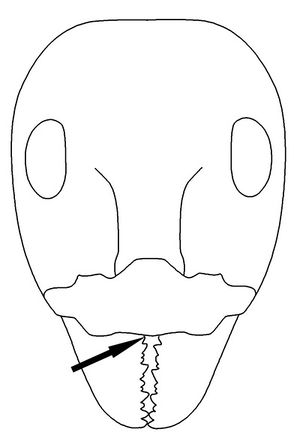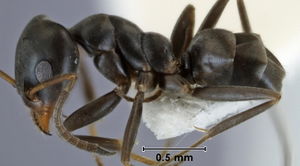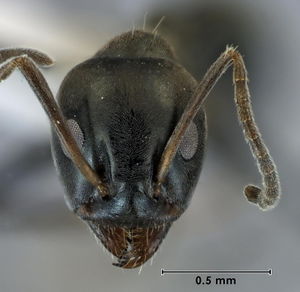Key to Iridomyrmex species
The following key to Iridomyrmex species is based on Heterick & Shattuck (2011[1]).
1
- In profile, petiolar node thick, very elongate and strongly inclined anteriad, the anterior face very short or even virtually absent; in full-face view, frontal carinae strongly concave => 2
- In profile, petiolar node not as above; frontal carinae moderately to weakly concave, straight or weakly convex => 5
2
- Head uniformly reddish, without infuscation; gaster with blue iridescence => Iridomyrmex rufoinclinus
- Head partially or wholly infuscated; gaster coppery, lacking blue iridescence => 3
3
- Infuscation limited to frons of head capsule, lateral and ventral surfaces of head reddish, matching colour of posterior mesosoma => Iridomyrmex cappoinclinus
- Entire head brown to black, contrasting with reddish colour of posterior mesosoma => 4
4
- Pronotum infuscated and darker than rest of mesosoma => Iridomyrmex anteroinclinus
- Pronotum of the same reddish colour as rest of mesosoma => Iridomyrmex cephaloinclinus
5
- In full-face view, anterior margin of clypeus weakly to strongly concave between its lateral lobes, its central point well posterior to an imaginary line connecting the outer margins of the lateral lobes, and the anteromedial clypeal prominence absent or denoted by a weak undulation; frontal carinae short (as long as distance between them) and usually concave, but may be straight => 6
- In full-face view, anterior margin of clypeus not concave between its lateral lobes, its central point at or anterior to an imaginary line connecting the outer margins of the lateral lobes, and usually with a weak to strong anteromedial clypeal prominence or undulation; frontal carinae often longer (i.e., longer than distance between them) and straight or weakly sinuate => 17
6
- In profile, propodeal spiracle situated near confluence of dorsal and declivitous faces of propodeum; petiolar node reduced to thick ridge => Iridomyrmex mirabilis
- In profile, propodeal spiracle situated well below dorsum of propodeum; well-developed petiolar node always present as a thick or thin scale-like projection => 7
7
- Mesosoma with very many (25 or more) erect hairs => 8
- Mesosoma with fewer (0–6) erect hairs => 15
8
- Cuticle strongly shining, with sculpture (where present) confined to a very weak, superficial reticulation; long, J-shaped hairs absent from underside of head capsule (a few slightly bent hairs may be present); appressed setae on mesosoma sparse, not hiding cuticle => Iridomyrmex innocens
- Cuticle not uniformly shining, coriaceous or shagreenate sculpture present; long J-shaped hairs present on underside of head capsule; appressed setae thick on some areas of mesosoma, hiding underlying cuticle => 9
9
- Head, body and appendages with weak blue to bluish-green iridescence; cuticular pigment uniformly brown to black => Iridomyrmex prismatis
- Blue or bluish-green iridescence (if present) confined to gaster; head and body never black and rarely uniformly brown, usually with light ochre to reddish head and mesosoma (with degrees of brown infuscation on frons and propodeum), and dark brown gaster => 10
10
- Tibiae lacking erect or semi-erect setae; node relatively thick, not scale-like (seen in profile, width of node greater than or equal to 0.6 × length of posterior face of node) => Iridomyrmex nudipes
- Tibiae with at least 3-4 semi-erect or erect setae (may be small and inconspicuous), often numerous setae present; node relatively thin and scale-like (seen in profile, width of node less than or equal to 0.5 × length of posterior face of node) => 11
11
- Smaller species (HW ≤ 0.95mm) => Iridomyrmex adstringatus
- Larger species (HW ≥ 1.14mm) => 12
12
- Head and mesosoma uniformly brown, gaster chocolate; legs concolorous with pronotum (one specimen from Crowdy Bay, New South Wales) => Iridomyrmex tenebrans
- Head and mesosoma not uniformly brown, pronotum, at least, yellowish to brick-red or reddish-brown, legs conspicuously darker than pronotum => 13
13
- In full-face view, frontal carinae straight (one specimen from Black Mtn, ACT) => Iridomyrmex infuscus
- In full-face view, frontal carinae visibly curved throughout all or most of their length => 14
14
- Antennal scapes relatively long (SI > 85) (Western Australia only) => Iridomyrmex hesperus
- Antennal scapes relatively short (SI < 85) => Iridomyrmex viridigaster
15
- Larger species (HL ≈ 1.40mm, HW ≈ 1.33mm, SL ≈ 1.03mm) => Iridomyrmex anderseni
- Smaller species (HL < 1.10mm, HW < 0.97mm, SL < 0.91mm) => 16
16
- Scapes longer (SL > 0.89mm, SI > 105, exceeding posterior margin of head by ≈ 3 × their greatest diameter); blackish-brown to black, shining species (New Caledonia) => Iridomyrmex obsidianus
- Scapes shorter (SL < 0.88mm, SI < 100, exceeding posterior margin of head by less than or equal to 1 × their greatest diameter); light brown to dark brown species, weakly shining to matte in appearance => Iridomyrmex calvus
17
- Propodeum expanded dorsally to form a triangular projection (best seen in side view) => 18
- Propodeum not so expanded, though it may be strongly protuberant => 20
18
- Erect or suberect hairs generally absent from pronotum, but when present short, stout and essentially straight => Iridomyrmex conifer
- More than eight gently curved erect or suberect hairs present on the pronotum => 19
19
- Lateral margin of head (in full face view) generally lacking erect hairs, but when present the posterior hairs are longer than the maximum scape diameter and distinctly curved => Iridomyrmex turbineus
- Lateral margin of head (in full face view) always with numerous short (less than maximum scape diameter), straight or very slightly curved erect hairs => Iridomyrmex setoconus
20
- Acute anteromedial clypeal prominence present as a conspicuous triangle; erect setae present on antennal scapes, sides of head and hind femora; frontal carinae distinctly sinuate with small flanges on carinae often tending to angulate medially; metathoracic spiracles prominent (medium-large to large ants, often with broad, triangular heads and purple, pink, blue or green iridescence on body and legs) => 21
- Anteromedial clypeal prominence not a conspicuous triangle (either a small blunt projection, an indistinct undulation of the cuticle or completely absent) or erect setae absent from one or more of antennal scapes, sides of head and hind femora; frontal carinae rarely distinctly sinuate => 31
21
- Propodeal dorsum straight or weakly convex; antennal scapes relatively long (SI > 109, surpassing posterior margin of head by 0.2–0.5 × their length) => Iridomyrmex roseatus
- Propodeal dorsum strongly convex and often protuberant; antennal scapes relatively short (scapes surpassing posterior margin of head by less than or equal to 2 × their greatest diameter) => 22
22
- Eyes large (EI ≥ 30); scapes with erect setae mainly confined to outer surface; in profile, mesonotum straight => Iridomyrmex bigi
- Eyes smaller (EI < 25); scapes with erect setae on all surfaces; in profile, mesonotum sinuate, convex anteriorly and flat to convex posteriorly => 23
23
- Antennal scapes short (SL < 1.30mm); in full-face view, anteromedial clypeal prominence shorter, not extending beyond lateral lobes of anterior clypeal margin; erect hairs on head and body fine and pale in colour => Iridomyrmex discors
- Antennal scapes long (SL > 1.37mm); in full-face view, anteromedial clypeal prominence longer, extending beyond lateral lobes of anterior clypeal margin; erect hairs on head and body typically bristly and dark in colour => 24
24
- Lateral and/or dorsal regions of head with at least weak but distinct green iridescence (often with purple iridescence as well) => 25
- Lateral and/or dorsal regions of head with purple or blue and occasionally weak greenish-yellow iridescence; (some SW I. purpureus), but never with distinctly green iridescence => 26
25
- Head similar in colour to mesosoma, or at most only slightly lighter => Iridomyrmex viridiaeneus
- Head always distinctly lighter in colour than mesosoma => Iridomyrmex galbanus
26
- Posterior region of pronotum (immediately anterior of the pro-mesonotal suture) in profile rising above the mesonotum in a short, strongly convex arch; lateral regions of head often with at most very weak purplish iridescence => 27
- Posterior region of pronotum (immediately anterior of the pro-mesonotal suture) in profile rising above the mesonotum in a broad, uniform, weakly convex arch; lateral regions of head with well developed iridescence (usually purple or blue) => 29
27
- Erect mesosomal setae pale; posterolateral region of first gastral tergite with less than six appressed setae; known only from New South Wales, southern Queensland and South Australia => Iridomyrmex spodipilus
- Erect mesosomal setae dark (sometimes superficially appearing pale when viewed against a lightly-coloured background); posterolateral region of first gastral tergite with more than eight appressed setae; mainly northern Australia north of about 24°N => 28
28
- In full face view, lateral margin of head with more than 4 erect or suberect hairs, and often with more than 10 => Iridomyrmex reburrus
- In full face view, lateral margin of head generally without erect or suberect hairs, but always with less than five => Iridomyrmex sanguineus
29
- Head light yellow-red, distinctly lighter in colour than the pronotum; known only from Queensland north of approximately Rolleston => Iridomyrmex spadius
- Head reddish brown, at most only slightly lighter in colour than the pronotum; widespread in southern Australia with one species in southern Queensland => 30
30
- Head and mesosoma dark reddish brown to black; head often with strong blue iridescence; propodeal dorsum often strongly arched, forming a blunt right angle as propodeum rounds into its declivitous face => Iridomyrmex lividus
- Head and mesosoma reddish brown; head with purple iridescence; propodeal dorsum generally rounded, not forming angle as propodeum rounds into its declivitous face => Iridomyrmex purpureus
31
- Second and third maxillary palp segments elongate so that their combined length is equal to or greater than palp segments 4–6 combined => Iridomyrmex trigonoceps
- Second and third maxillary palp segments individually about as long as or only slightly longer than segments 4–6, so their combined length is much less than combined length of segments 4-6 => 32
32
- Semi-erect to erect setae present on antennal scapes and hind tibiae (and, often, sides of head) => 33
- Semi-erect to erect setae absent from antennal scapes, or hind tibiae, or both parts => 43
33
- Broad-headed (CI 90 or more), yellow, depigmented, tropical species; eye with distinctly protuberant anteromedial margin; in full-face view, eyes placed at least 0.5 × their own diameter away from sides of head; setae on scapes small and suberect or subdecumbent, erect and suberect setae present on legs => Iridomyrmex pallidus (part)
- If yellow and depigmented, differing from the above in respect of the appearance and placement of the eyes, and the narrower head => 34
34
- Eye with distinctly protuberant anteromedial margin, and a posterior lobe that is narrower than its anterior lobe; yellow, depigmented ants => Iridomyrmex macrops (part)
- Eye with, at most, a slightly protuberant anteromedial margin, and a posterior lobe that is not narrower than its anterior lobe; ants bicoloured or concolorous reddish-brown to black => 35
35
- Ant with reddish or reddish brown foreparts, darker gaster without iridescence; anterior pronotum strongly arched at angle of 60º or more; antennal scapes shorter, barely surpassing posterior margin of head => Iridomyrmex chasei (part)
- If ant with short antennal scapes, then anterior pronotum less strongly arched at angle of 60° or less, and gaster with blue-green or greenish-yellow iridescence => 36
36
- Antennal scapes relatively short, surpassing posterior margin of head by maximum of 1-1.5 × their greatest diameter; hind femur shorter, less than 0.8 × length of mesosoma => 37
- Antennal scapes longer, surpassing posterior margin of head by minimum of 2 × their greatest diameter; hind femur longer, greater than or equal to 0.85 × length of mesosoma => 40
37
- Sides of head mostly lacking short, erect hairs, where present, these concentrated around mandibular insertion (shiny brown ants from inland Australia) => Iridomyrmex fulgens
- Sides of head with many short, erect hairs along their length => 38
38
- In full-face view, posterior margin of head planar; in profile, curve of anterior pronotum usually broad and gradual, when viewed dorsally, pronotum tapering gradually towards its anterior flange => Iridomyrmex suchieri (part)
- In full-face view, posterior margin of head distinctly concave; in profile, curve of anterior pronotum more distinctly circular, when viewed dorsally, pronotum tapering sharply towards its anterior flange => 39
39
- Propodeum smoothly rounding onto its declivitous face without noticeable angle, declivitous face straight or weakly convex; bicoloured ants, often with reddish or orange foreparts (Australia) => Iridomyrmex rufoniger (part)
- Propodeum abruptly rounding onto its declivitous face through a blunt angle of 90°, declivitous face weakly concave (brown ants with weakly metallic gaster from Phillip Island only) => Iridomyrmex phillipensis
40
- Antennal scapes surpassing posterior margin of head by greater than or equal to 0.35 × their length; larger species (HW ≥ 0.95mm); bluish-green to yellow green iridescence often present on body and legs in darker, brown to black specimens, tending towards pinkish-purple on reddish workers => Iridomyrmex mayri
- If larger (HW ≥ 0.95mm), then scapes surpassing posterior margin of head by less than or equal to 0.30 × their length; distinct iridescence absent on head and mesosoma (may be coppery or faintly bluish-green on gaster) => 41
41
- Densely hairy, longest setae on antennal scapes and tibiae greater than or equal to greatest diameter of scape and tibia; semi-erect setae present on dorsal surface of fore basitarsus => Iridomyrmex spurcus
- Longest setae on antennal scapes and tibiae less than greatest diameter of scape and tibia; semi-erect setae absent from dorsal surface of fore basitarsus => 42
42
- Ratio of propodeal dorsum to propodeal declivity ≈ 1:1; generally larger species (HW 0.85–1.19mm); scapes surpassing posterior margin of head by less than or equal to 0.30 × their length; in profile, dorsum of propodeum always convex, shorter: confined to eastern Queensland, New South Wales, ACT and Victoria => Iridomyrmex obscurior
- Ratio of propodeal dorsum to propodeal declivity greater than 1:1; generally smaller species (HW 0.60–0.90 mm); scapes length variable, surpassing posterior margin of head by greater than 0.30 × their length in larger workers; in profile, dorsum of propodeum often rather elongate and flattened; mainly Western Australia and South Australia => Iridomyrmex omalonotus
43
- Erect setae present on antennal scapes, but absent from hind tibiae (gracile, black species with blue iridescence from SW Western Australia) => Iridomyrmex longisoma
- Erect setae absent from antennal scapes => 44
44
- Hind tibiae with distinct erect and/or semi-erect setae in addition to appressed or decumbent setae (may be sparse) => 45
- Hind tibiae without distinct erect and/or semi-erect setae => 52
45
- Eye with distinctly protuberant anteromedial margin, and a posterior lobe that is narrower than its anterior lobe => 46
- Eye with, at most, a slightly protuberant anteromedial margin, and a posterior lobe that is not narrower than its anterior lobe => 47
46
- Antennal scapes short (SL < 0.73mm, SI < 110, surpassing posterior margin of head by only their own maximum diameter) => Iridomyrmex cupreus
- Antennal scapes long (SL > 0.73mm, SI > 110, surpassing posterior margin of head by 0.25 × their length) => Iridomyrmex macrops (part)
47
- Antennal scapes relatively short (SL < 0.93mm and SI < 97, surpassing posterior margin of head by less than their greatest diameter); posterior margin of head concave, with erect hairs on vertex not extending to sides; gaster nearly always with blue, greenish-blue or greenish-yellow iridescence => Iridomyrmex rufoniger (part)
- Antennal scapes relatively long (SL > 0.93mm or SI > 96); posterior margin of head planar to strongly convex, with or without erect hairs on the sides => 48
48
- In full-face view, erect hairs confined to posterior margin of the head; erect setae on hind tibia sparse, often confined to one or two => Iridomyrmex anceps (part)
- In full-face view, erect hairs extending along lateral margins of head to at least the eyes; typically, erect setae on hind tibia moderately plentiful to abundant and extending along length of tibia => 49
49
- Antennal scapes short (SL < 0.90mm, surpassing posterior margin of head by 2 × their greatest diameter or less); less gracile (length of hind femur less than 0.75 × length of mesosoma); gaster often with weak bluish-green or yellow-green iridescence => Iridomyrmex suchieri (part)
- Antennal scapes long (SL > 0.90mm, surpassing posterior margin of head by at least 0.2 × their length, i.e., much more than 2 × their greatest diameter); more gracile (length of hind femur greater than 0.82 × length of mesosoma); gaster without iridescence => 50
50
- In full-face view, head capsule subrectangular, the posterior margin planar => Iridomyrmex minor (part)
- In full-face view, either head capsule distinctly oval or its posterior margin strongly convex => 51
51
- In profile, pronotum and mesonotum combined forming a very weak, almost imperceptible arc; in full-face view, posterior margin of head strongly convex; antennal scapes long (SL > 1.15mm, SI > 150, surpassing posterior margin of head by 0.4 × their length) => Iridomyrmex elongatus
- In profile, pronotum and mesonotum forming a moderate convexity; in full-face view, posterior margin of head very weakly concave to very weakly convex; antennal scapes short (SL < 1.15mm, SI < 110, surpassing posterior margin of head by less than 0.3 × their length) => Iridomyrmex curvifrons
52
- Head in full-face view extremely narrow (CI 64–70); in dorsal view, pronotum tapering very weakly towards its anterior margin; eyes large (EL > 0.24mm, EW > 0.19mm, EI > 38, eye width greater than or equal to 3 × greatest diameter of antennal scape) => 53
- Without above combination of three characters (in similar species, eye either smaller or pronotum strongly tapered towards its anterior margin) => 54
53
- Mesosoma glabrous (lacking hairs) => Iridomyrmex tenuiceps
- Mesosoma with very short, bristly hairs (mainly New Guinea and Torres Strait) => Iridomyrmex angusticeps
54
- Broad-headed (CI ≥ 90), yellow, depigmented, tropical species; eye with distinctly protuberant anteromedial margin; in full-face view, eyes placed at least 0.5 × their own diameter away from sides of head; setae on scapes and legs very small, all of same size and decumbent or subdecumbent, often giving these parts a shaggy appearance (best seen against a dark background) => Iridomyrmex pallidus (part)
- If yellow and depigmented, differing from the above in respect of the appearance and placement of the eyes, and setae on scapes and legs => 55
55
- Head in full-face view elongate (CI < 83), upper vertex rather broad above eyes; in full-face view, eyes placed at about midpoint of head; anteromedial margin of clypeus produced as a sharp, narrowly triangular tooth; hind femur very long, length greater than or equal to length of mesosoma => 56
- If head elongate (e.g., I. bicknelli), then length of hind femur less than length of mesosoma or, in full-face view, eyes placed above midpoint of head, upper vertex narrow compared with region below eyes and anteromedial clypeal margin not produced as a sharp, narrowly triangular tooth => 57
56
- Mesonotum and propodeum brown, contrasting with orange head and brownish-orange pronotum; seen in full-face view, sides of head without short, erect hairs except for a few around mandibular insertions; mesic habitats (coastal New South Wales and Queensland) => Iridomyrmex rubriceps
- Very colour variable, but never as above (commonly light orange to reddish with brownish gaster, but dark red and even dark bluish-red forms can occur); seen in full-face view, usually with few to many short, erect hairs on sides of head; drier habitats throughout Australian mainland => Iridomyrmex agilis
57
- Brown to dark brown species with blue, pinkish-purple or pink iridescence over entire body; eye with marked anteromedial protuberance; in profile, junction of dorsal and declivitous propodeal face abrupt, even carinate, declivitous face of propodeum vertical and flat or slightly bent anteriad, giving this structure the appearance of having been sectioned => Iridomyrmex cyaneus
- If ant brown or dark brown and iridescent, then appearance not as above, and propodeum never with abrupt junction between dorsal and declivitous faces => 58
58
- Eye distinctive, with protuberant anteromedial margin, and a posterior lobe that is narrower than its anterior lobe; most commonly depigmented or tawny yellow => 59
- Eye without protuberant anteromedial margin, or, if somewhat asymmetrical, then posterior lobe of eye not narrower than anterior lobe => 61
59
- Erect hairs short, pronotal and mesonotal hairs fewer than 6, often mesosoma glabrous (lacking hairs); in profile, propodeum strongly protuberant; in full-face view, posterior margin of head weakly to strongly concave => Iridomyrmex hartmeyeri
- Mesosoma always with some pilosity, and if propodeum protuberant or truncate in profile, then with 6 or more short mesosomal hairs, hairs often numerous; in full-face view, posterior margin of head generally slightly convex or planar, but may be very weakly concave => 60
60
- In profile, propodeal dorsum curved on to its declivitous surface through a blunt to sharp right angle, propodeum truncate and often weakly protuberant; colour mainly pale, depigmented yellow, occasionally tawny brownish-yellow (northern species) => Iridomyrmex exsanguis
- In profile, propodeal dorsum curved on to its declivitous surface smoothly, without distinct right angle, propodeum relatively short and truncate to elongate, rarely protuberant; colour variable, from yellow to dark brown, gaster and head often darker than mesosoma and appendages => Iridomyrmex dromus
61
- Antennal scapes surpassing posterior margin of head by 1/3–1/2 of their length or workers with bright orange, orange-red or variegated head capsule and scapes that surpass posterior margin of head by ≈ 3 × their greatest diameter; workers more slender, with relatively elongate, often low propodeum (length of dorsum greater than length of declivitous face); eyes anteriorly divergent in several species; vertex in full-face view convex, straight or gently concave; anteromedial clypeal protuberance usually present as a blunt to sharp triangle => 62
- Without this combination of characters; in particular, red and orange-headed workers with a deeply concave posterior margin of the head, and antennal scapes not or only barely surpassing the posterior margin of the head or propodeum short and truncate or protuberant => 72
62
- Ant with reddish foreparts and with bluish-green to purple iridescence on head and mesosoma => Iridomyrmex azureus
- Ant without such iridescence, or ant black => 63
63
- Small species (HW 0.70–0.75mm); dull brown with faint coppery reflections; head rather narrow (CI < 79); sides of head parallel or weakly convex; posterior margin of head planar; mandibles and often much of clypeus bright yellow => Iridomyrmex luteoclypeatus
- Without the above combination of characters (Iridomyrmex bicknelli is close, but here CI is usually less than 79, posterior margin of head is weakly to strongly convex, and sides of head converge towards mandibles) => 64
64
- Head elongate, narrow (CI < 79); sides of head convergent towards mandibles; posterior margin of head weakly (many Western Australian populations) to strongly (Eastern states) convex; ant dark brown to black with coppery, yellowish-green to more distinctly bluish iridescence (iridescence absent from some older material) => Iridomyrmex bicknelli
- If ant dark brown to black, then head less elongate (CI > 82); posterior margin of head planar or concave, and sides of head convex or parallel => 65
65
- Side of head with at least six erect hairs; colour various shades of red or brown, but gaster always darker than mesosoma or mandibles larger (crossed mandibles ≈ 0.25 × head length) => 66
- Side of head usually without erect hairs; if hairs present, then body concolorous, coppery dark brown or mandibles smaller (crossed mandibles ≈ 0.20 × head length) => 67
66
- Anteromedial clypeal prominence a distinct, triangular spur that projects between the anterolateral clypeal lobes; in profile mesonotum straight or slightly sinuate, not forming an even curve with the pronotum => Iridomyrmex minor (part)
- Anteromedial clypeal prominence vestigial, barely forming an interruption in the curve between the anterolateral clypeal lobes; in profile mesonotum weakly convex, forming an even curve with the pronotum => Iridomyrmex brunneus (part)
67
- Pronotum and mesonotum glabrous or with 1–6 minute hairs (length of hairs much less than narrowest diameter of antennal scape) => 68
- Longer pronotal hairs longer than or equal to greatest diameter of antennal scape => 69
68
- Body variegated blackish-red, head infuscated reddish-black; larger (HW > 1.25mm, ML > 2.03mm) => Iridomyrmex brennani
- Head reddish-orange to dark brown, mesosoma light orange to brown, usually with lighter patches but colour combination never as above; smaller (HW < 1.25mm, ML < 2.04mm) (a few populations) => Iridomyrmex minor (part)
69
- Head, mesosoma, and fore coxae bright orange, legs brown, gaster dark brown (NW Western Australia) => Iridomyrmex xanthocoxa
- If foreparts red or reddish, then fore coxae brown, agreeing with colour of remaining leg segments => 70
70
- Anteromedial clypeal prominence vestigial, barely forming an interruption in the curve between the anterolateral clypeal lobes; in profile mesonotum weakly convex, forming an even curve with the pronotum; body and legs not uniformly brown => Iridomyrmex brunneus (part)
- Anteromedial clypeal prominence a distinct, usually triangular spur projecting between the anterolateral clypeal lobes; in profile mesonotum straight or slightly sinuate, not forming an even curve with the pronotum or body and legs uniformly brown => 71
71
- Concolorous brown to dark brown, often with coppery reflections; hairs on pronotum and mesonotum short and bristly, their length not exceeding greatest diameter of the eye; length of hind femur variable, but usually less than 0.90 × length of mesosoma => Iridomyrmex anceps (part)
- Not concolorous brown (generally, gaster darker than body, and head and foreparts often with varying degrees of reddish or orange coloration); length of hairs on pronotum and mesonotum often exceeding greatest diameter of the eye; length of hind femur greater than or equal to 0.90 × length of mesosoma => Iridomyrmex minor (part)
72
- In profile, posterior region of head flattened, giving it a wedge-shaped appearance (dull brown, NW Western Australia species) => Iridomyrmex cuneiceps
- In profile, head rounded normally => 73
73
- In full-face view, posterior margin of head broadly concave, posterolateral corners angulate; pronotum without erect hairs; gaster without iridescence; in profile, propodeum truncate and protuberant => Iridomyrmex gumnos
- In full-face view, if posterior margin of head broadly concave with posterolateral corners angulate, gaster lacking iridescence and propodeum truncate and protuberant in profile, then pronotum with erect hairs => 74
74
- In full-face view, posterior margin of head broadly concave, posterolateral corners broadly angulate; propodeum narrowly protuberant; head and mesosoma without iridescence; if gaster with blue-green reflections then ground colour of gaster black and foreparts bright orange with or without some brown infuscation, usually gaster with coppery reflections only; pronotum with few to many erect hairs => 75
- In full-face view, if posterior margin of head broadly concave and posterolateral corners broadly angulate, then gaster shades of brown with generally faint to strong blue-green to yellow-green iridescence, or head, mesosoma and gaster generally with faint to strong blue-green to yellow-green iridescence; pronotum often with one or two small erect hairs only => 76
75
- In profile, anterior pronotum humped, arising steeply at angle of ≈ 60 º, ascending curve of pronotum much more steeply inclined than descending curve of mesonotum; posterior margin of head noticeably and broadly concave in full-face view; pronotum usually with 10 or more erect hairs; variably coloured, but cuticle of head and mesosoma usually with reddish tinge, most commonly orange or brownish-orange, or brown with orange highlights => Iridomyrmex chasei (part)
- In profile, anterior pronotum moderately inclined at angle of ≈ 45 º, ascending curve of pronotum almost identical with descending curve of mesonotum; posterior margin of head weakly concave or almost planar in full-face view; pronotum often with 6 or fewer erect hairs; uniformly brown (compact, small species (HL < 0.72mm, HW < 0.67mm, SL < 0.66mm, ML < 0.86mm) from northern Western Australia, Queensland and the Northern Territory, easily confused with I. chasei => Iridomyrmex gibbus
76
- In full-face view, erect hairs extending along sides of head => Iridomyrmex suchieroides
- In full-face view, erect hairs either absent or confined to posterior margin of head => 77
77
- Eyes large (EL ≈ 0.26mm, EW ≈ 0.21mm, eye width = 2.5 × greatest diameter of antennal scape), almost semi-circular in shape; anteromedial clypeal prominence well defined and acute; head capsule rather elongate (CI ≈ 78) (known only from Lake Mere, New South Wales) => Iridomyrmex atypicus
- Eyes not as above or head broader and more square (CI > 85) or anteromedial clypeal prominence weakly developed, vestigial or absent => 78
78
- Eyes rather large (eye width greater than or equal to 2 × greatest diameter of antennal scape); entire body usually with weak to moderate bluish- or yellowish-green iridescence, iridescence may be absent in some populations, especially those found outside of Australia; mandible very pale, much lighter in colour than head in Australian workers; underlying cuticle coriaceous, weakly to moderately shining; short, pale, bristly hairs present on mesosoma; anteromedial clypeal prominence broad and well developed; curved hairs longer than greatest diameter of eye present on venter of head (may be abraded) => Iridomyrmex coeruleus
- If ant with bluish- or yellow-green iridescence and pale, bristly hairs, then either eye smaller (eye width less than or equal to 1.5 × greatest diameter of antennal scape) or curved hairs on underside of head (if present) shorter; or if ant lacks bluish- or yellow-green iridescence and pale, bristly hairs then anteromedial clypeal prominence absent or vestigial (e.g., I. niger, which is superficially similar); underlying cuticle (in all cases) often superficially microreticulate, shining => 79
79
- In full-face view, frontal carinae straight; in profile, propodeum narrow, protuberant, often forming a rounded, low cone; generally larger species (most specimens HW > 0.76mm => Iridomyrmex alpinus
- Frontal carinae weakly convex; in profile, propodeum not protuberant as above or forming a rounded, low cone; most species with HW < 0.76 mm => 80
80
- Very small, mostly coal-black or bluish ants, rarely dark, shining yellowish brown (I. hertogi) (HL ≈ 0.59–0.76mm, HW ≈ 0.51–0.65mm, ML ≈ 0.71–0.99mm), appearance as in I. coeruleus, some workers completely glabrous, except for one or two tiny bristles on propodeum, while others have short, bristly hairs; in full-face view, sides of head convergent anteriad; in profile, mesosoma forming a seamless, even curve; head narrow (CI ≈ 84–86); anteromedial clypeal margin without prominence; propodeum truncate, tending to protuberant in profile => 81
- If ant very small (i.e., HW < 0.55mm), then body shades of brown and, in full-face view, head rectangular (i.e., CI > 85, except in a few I. mjobergi workers, which are brown ants), sides of head not noticeably convergent anteriad; erect, non-bristly hairs usually present (absent in northern I. difficilis), at least on margins of gastral tergites; head width variable; anteromedial clypeal prominence usually noticeable => 82
81
- Body smaller (HL < 0.61mm, HW < 0.52mm, ML < 0.73mm); confined to northern Australia => Iridomyrmex hertogi
- Body larger (HL > 0.61mm, HW > 0.52mm, ML > 0.77mm); confined to SE Australia => Iridomyrmex niger
82
- Antennal scapes very short (SL < 0.60mm and SI < 97, surpassing posterior margin of head by less than their greatest diameter) => 83
- Antennal scapes longer (SL > 0.60mm and SI > 97, surpassing posterior margin of head by at least 1.5 × their greatest diameter) => 85
83
- Mesosoma with many short, bristly hairs throughout; mandible dark, concolorous with head or nearly so; confined to Tasmania => Iridomyrmex mattiroloi
- Mesosoma either glabrous or with sparse to moderate non-bristly hairs mainly on pronotum; colour of mandible yellow to darkish orange, distinctly lighter in colour than head; found throughout Australian mainland as well as Tasmania => 84
84
- In full-face view, antennal scapes not or barely breaking the outline of the posterior margin of head (SL < 0.55mm, SI < 95); in profile, worker usually with relatively steep curve to the anterior pronotum; metanotal groove deep, with propodeum either narrow and protuberant or narrow and truncate; smaller, brown species => Iridomyrmex difficilis
- In full-face view, antennal scapes slightly longer (surpassing posterior margin of head by at least 1 × greatest diameter of scape, SL > 0.50mm, SI > 91); anterior pronotum usually an even curve; metanotal groove relatively weak, propodeum may be narrow and truncate (a few small workers) but never protuberant; mostly larger species => Iridomyrmex mjobergi (part)
85
- In profile, length of dorsum of propodeum greater than length of its declivitous face, and also greater than length of its base; dorsum of propodeum straight or only weakly convex; posterior margin of head with row or aggregation of short hairs => Iridomyrmex suchieri (part)
- In profile, if appearance of propodeum broadly as above (some I. mjobergi), then posterior margin of head lacking row or aggregation of short hairs => 86
86
- Posterior sector of propodeum flattened, so that propodeal angle is more-or-less erased and propodeal spiracle is near confluence of dorsal and declivitous propodeal faces; antennae usually longer, antennal scapes surpassing posterior margin of head by greater than or equal to 2 × its greatest diameter in most specimens; ant glossy blackish-brown with strong coppery reflections => Iridomyrmex continentis
- If ant similar (some northern populations of I. mjobergi), then propodeal spiracle placed well below flattened region of dorsum of propodeal dorsum, and antennal scapes surpasses posterior margin of head by less than or equal to 1.5 × its greatest diameter => 87
87
- Antennal scapes longer (SL > 0.92mm, SI > 112, surpassing posterior margin of head by ≈ 3 × its greatest diameter) (New Caledonia) => Iridomyrmex neocaledonica
- Antennal scapes shorter (SL < 0.92mm, SI < 116 (but usually < 110), surpassing posterior margin of head by less than or equal to 2 × its greatest diameter at a maximum, usually by less) (Australia) => 88
88
- Head weakly to moderately, but evenly concave when seen in full-face view; when seen in profile, propodeum truncate to protuberant, with straight to concave declivitous surface; weak bluish- to yellowish green iridescence usually present in fresh material, but confined to gaster => Iridomyrmex victorianus
- Without above combination of characters: in particular, if propodeum truncate or protuberant, then ant with planar posterior margin of head and coppery brown without noticeable iridescence on gaster, or ant with iridescence on both body and gaster => 89
89
- Seen in full-face view, posterior margin of head surmounted by row or aggregation of short, erect hairs; most populations uniformly dark brown or black with uniform weak bluish- to yellowish-green iridescence, but non-iridescent bicoloured brown-and-dark-brown, or even light-brown-and-orange workers can occur => Iridomyrmex splendens
- Seen in full-face, posterior margin of head with a few well-dispersed hairs, or a well-separated pair of hairs or without erect hairs; where several hairs present, ant without distinct iridescence or bicoloured as above => 90
90
- Head, mesosoma and gaster with very weak to moderate yellowish- or bluish-green iridescence in Western Australian workers; pronotum normally glabrous across all populations, but may have one or two tiny bristly, erect hairs; mandibles commonly brown to dark brown but may be orange in Western Australian populations, concolorous with head capsule in Tasmanian material that lacks noticeable iridescence; antennal scapes surpassing posterior margin of head by ≈ 2 × its greatest diameter (blackish ants confined to Tasmania and the extreme south and southwest of Western Australia) => Iridomyrmex meridianus
- Rarely with iridescence on head, mesosoma and gaster, if present (SW Australia, rare) then pronotum with several erect, bristly hairs and mandible orange, contrasting with blackish head capsule; mandible also always lighter in colour than head capsule in non-iridescent populations; antennal scapes generally shorter, surpassing posterior margin of head by 1.5–2 × its greatest diameter; mesosoma often with erect hairs, although may be lacking in specimens from drier environments => Iridomyrmex mjobergi (part)
References
- ↑ Heterick, B. E. & Shattuck, S. (2011) Revision of the ant genus Iridomyrmex (Hymenoptera: Formicidae). Zootaxa 2845: 1-174.



